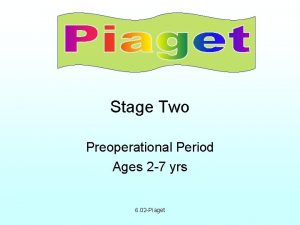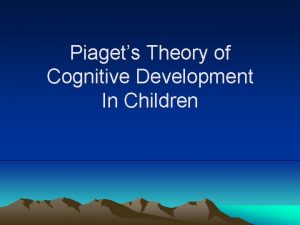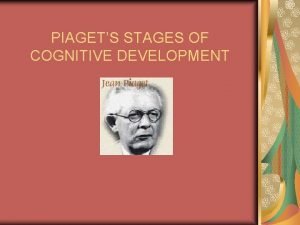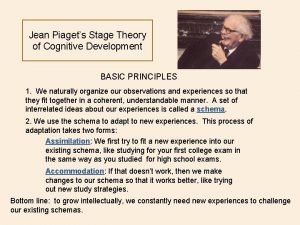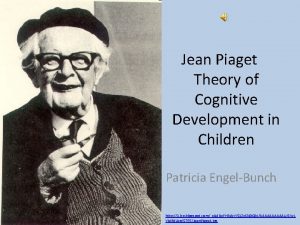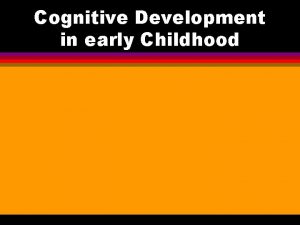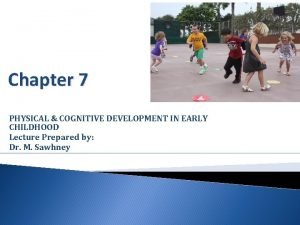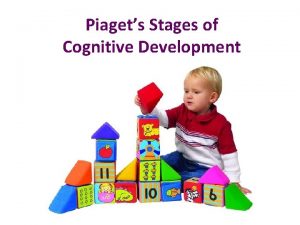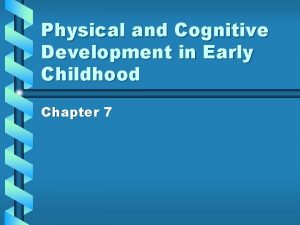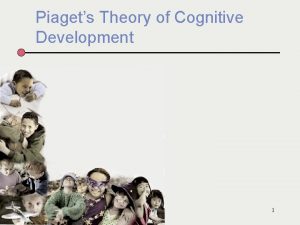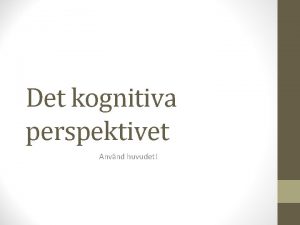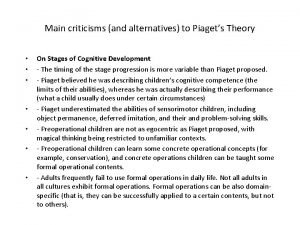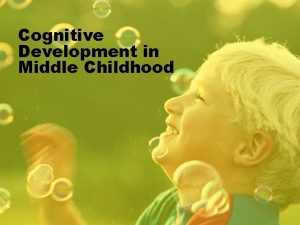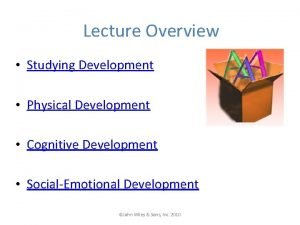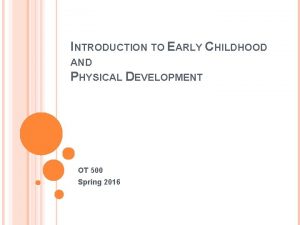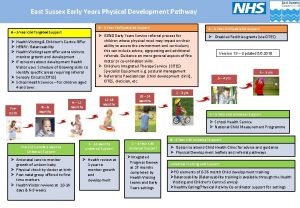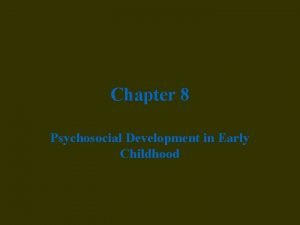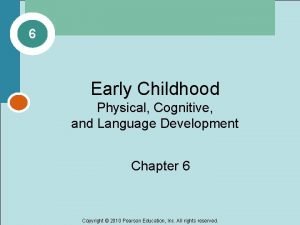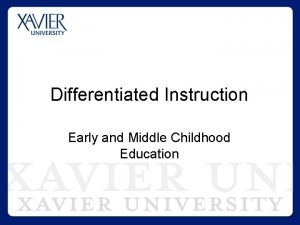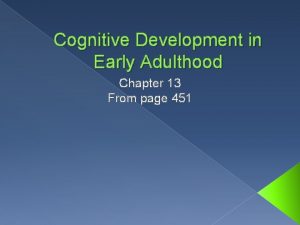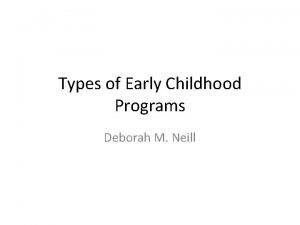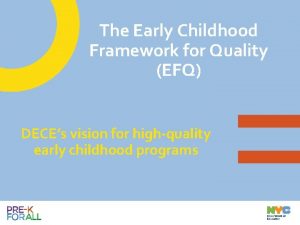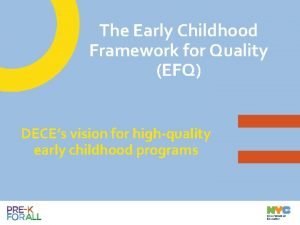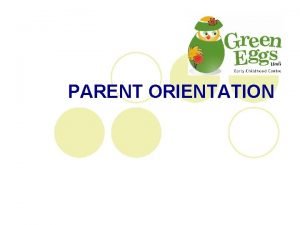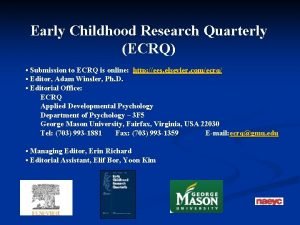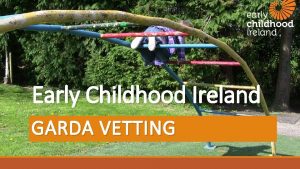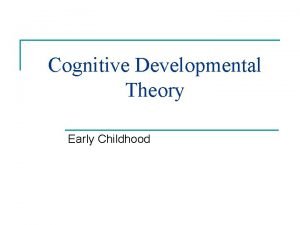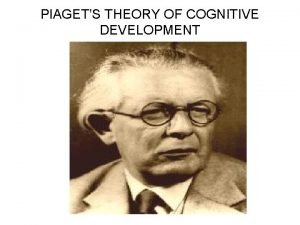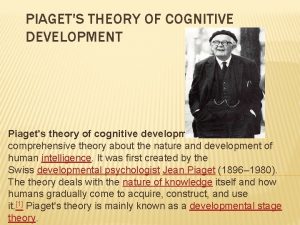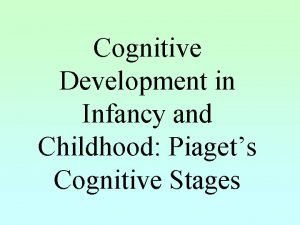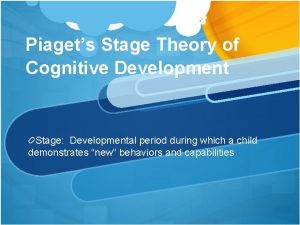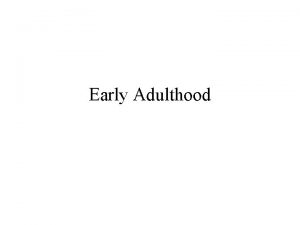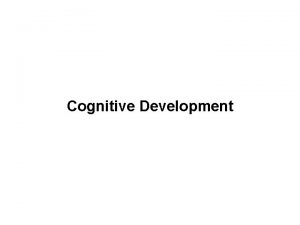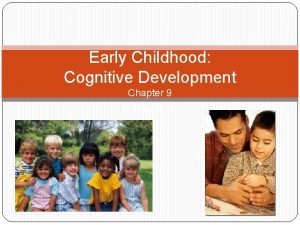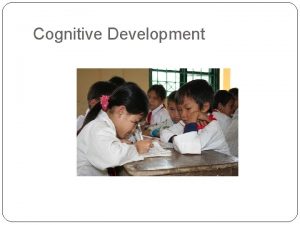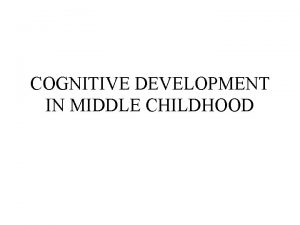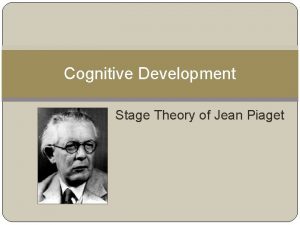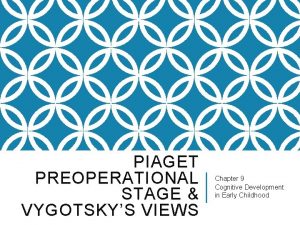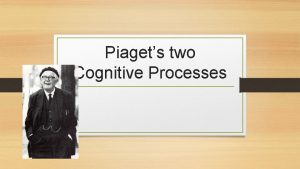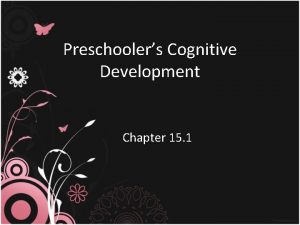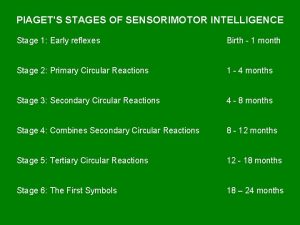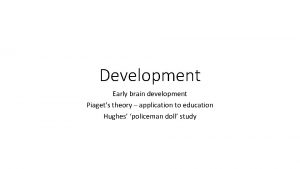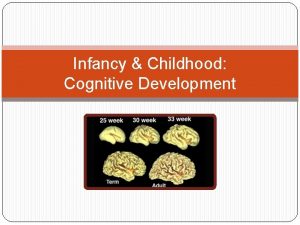Cognitive Development in early Childhood Piagets Preoperational Stage












































- Slides: 44

Cognitive Development in early Childhood

Piaget’s Preoperational Stage l l l Stage begins around 2 and lasts to around seven years of age During the preoperational stage the child becomes increasingly proficient at using symbols (words or actions that stand for other things) (not algebraic) They extend their belief in object permanence to include identities (constancies)

Piaget’s Preoperational Stage (continued) l They begin to sense function relationships (variations in the environment that normally occur together) such as walking and speed: The faster you walk, the faster you will get somewhere

Piaget’s Preoperational Stage l l The “pre” of preoperational implies focuses on the limitations of young children thinking relative to that of older, school-age children The term “operations” refers to mental actions that allow a child to reason about events he or she experiences

Piaget’s Preoperational Stage (continued) l l Some of their limitations include: Classifying objects and events logically Confusing their own point of view with those of other people Significant achievement of preoperational thinking is symbolic thought (one symbol, one referent)

Egocentrism in Preschool Children l l Egocentrism--is the tendency of a person to confuse his or her own point of view and that of another person Centering on the self in thinking

Piaget's Three Mountains Experiment

Aspects of Conceptual Development (1) l l Classification--placement of objects in groups/categories according to some specific standards 3 year olds can classify objects that differ in only one dimension or characteristic (ex. Sorting money by color)

Aspects of conceptual development (2) l Interestingly, while the early childhood mind persists in onedimensional classification, this later is a persistent theme in mental retardation

Aspects of Conceptual Development (3 of 7) l l l Reversibility and Conservation. Reversibility in thinking--the ability to undo a problem mentally and go back to its beginning Reversibility contributes to a major cognitive achievement of middle childhood: conservation

Aspects of Conceptual Development (4 of 7) l l Conservation-the ability to perceive that properties of an object remain the same despite changes in the object’s appearance Usually by age six

Original Setup Conservation of liquid Alter as Shown Ask Child Which has more liquid? Has more Conservation of mass Do they both weigh the same, or does one weigh more than the other? Conservation of number Are there still as many pennies as nickels, or more of one than the other? Conservation of length Usual Answer Weighs more More Are they the same length, or is one longer? Is longer Is one pencil as long as the other, or is one longer? Is longer

Aspects of Conceptual Development (5 of 7) l l Conservation of Numerosity-Children do not grasp the conventional numbering systems during the first few years of life

Aspects of conceptual development (6 of 7) l Conservation of Mass--the most cited aspect of the transition from preoperational thought to concrete thought

Aspects of Conceptual Development (concluded) l l Children internalize knowledge not only by manipulating objects and observing the results of the manipulations but by interacting with parents, teachers and peers The range of “just possible” learning situations is called the zone of proximal development

Piaget’s Preoperational Stage) l l Symbolic thinking helps preschool children to organize and process what they know (placing labels and descriptions on objects and experiences) Symbols help the child to communicate what they know to others

Piaget’s pre-operational stage (2) l l Communication fosters social relationships among children Communication also fosters cognitive development by allowing children to learn from experiences of others

A re-visit to relevant theories • Social Learning Theories: Language acquisition through imitation or modeling • Reinforcement: The child is conditioned to perform verbal behavior. (B. F. Skinner, 1957) • Innateness: We are “pre-wired” or “preprogrammed” to learn language through a language acquisition device (L. A. D. ) in the brain. (Chomsky) • Combined View: Includes predisposition and input from the environment, but the child plays an active, creative role in learning language. Perception, cognition, motor, social and emotional factors are all involved.

Neostructuralist Theories l These neo. Piagetian theories have roots in Piaget’s research and stage thinking, but focus on more precise areas of how thinking occurs

Language Acquisition

Language Concepts (1) l l Phonology is the sound system of a language and the rules that govern the sound combination. For instance, English has a ph blend but not a hp. Morphology is the system that governs the structure of words and the construction of word forms. “Unhappy” is a possible word but not “hapunpy”

Language concepts (2) l l l Syntax is the system governing the order and combination of words to form sentences, and the relationships among the elements within a sentence. “He kissed her” not = “Her kissed him. ” “The shooting of the hunters was awful”--? Meaning.

Language concepts (3) l l Semantics is the system that governs the meanings of words and sentences “Construct” means different things to engineers and psychologists

Language concepts (4) l l Pragmatics is the system that combines all of the language components into functional communication As in, would you get this close to talk to anybody?

Duos l Two-word sentences without modifiers-”Daddy hammer” --many possible meanings

Semantic Relations in Two-Word Utterances Relationship Example Agents + action Action + object Agent + object Action + locative (location) Object + locative Possessor + possessed Attribute + object Demonstrative + object Baby cry Eat cookie Bobby cookie Jump stair Teddy bed Mommy sandwich Big dog There Daddy

Holographic speech l l Holographic speech and telegraphic speech are other names for duo speech With two-word sentences, there is insufficient predictability about what the child may have meant

Predisposition to Infer Grammar l l l Grammar, like values, seems to be more “caught” than “taught” Studying rules of grammar has some usefulness, but it is not totally effective This is how students can study grammar for 14 years and still be ineffective writers


Mechanisms of language acquisition l l l Behaviorism Positive reinforcement Extinction Shaping Chaining These cannot account for novel utterances

Imitation and practice l The correspondence of children’s speech patterns to significant adults’ shows some modeling (Bandura)

Language Acquisition Device (LAD) l l Helps explain novel utterances when children experience impoverished oral stimulation Cannot argue that experience plays no part

Gender differences l l Gender differences are heaviest in pragmatics Girls’ requests are more indirect than boys’, usually Females maintain more eye contact Boys blink more regularly and nod less

SES differences l l Middle- and upper-class speak in “test” format more “Name” and “locate” things more--are more specific with labels than low.

Indicators of hearing loss l l l Physical problems associated with the ears Articulates poorly and omits consonant sounds (speech banana) Turns up volume on radio, TV, stereo Requests repetitions; “huh? ” Unresponsive to normal voice


Special learning challenges for the hearing-impaired l l l Multiple word meanings such as mole or box Syntax as it relates to word order: “The parent spanked the child” as compared to “The child spanked the parent. ” Idioms such as “He pulled himself up by his bootstraps”

Special challenges for the hearing-impaired l l Figurative language such as “He’s one up on me” and “Give me some slack. ” Idioms such as “He pulled himself up by his bootstraps” and “Let’s meet at twelve o’clock sharp. ”

Total Communication Method l l l Combines finger spelling, speech reading, speech, and auditory amplification Most common method of classroom communication, followed by oral-aural Manual communication was not reported as a major mode of instruction in any school

Where do you seat the hearing impaired? l l For unilateral losses, with the good ear towards you, the teacher For bilateral, second row, middle, rather than on the front

FM transmitters/receivers l l Student wears receiver with earphone Teacher wears transmitter Amplifies teacher’s voice without amplifying all other classroom noise Take it off when you aren’t using it! If you don’t want to embarrass yourself.

Surface vs. deep structure l l Both the hearing impaired and the autistic share an absence of the deep structure of the language Deep structure enables us to understand “to, ” “too, ” and “two, ” “herd” & “heard”

Leaving early childhood • Preoperational thinking, not yet logical, unable to see another’s viewpoint. • Child has gone through “language explosion, ” emerging with vocabulary of over 14, 000 words, and syntactically correct usage.

Leaving early childhood (Age 7) • Conservation has developed. • Classification and categorization have developed. • Ability to resolve contradictions. • Comprehension of past, present, and future. • Understanding of reversibility; child has control and flexibility. • Using the alphabet for organization. • Ability to verbalize directions. • Ability to transpose (i. e. , see things from another’s viewpoint). • Comprehension of relational terms. • Can use simple logic.
 A vygotskian classroom promotes ________.
A vygotskian classroom promotes ________. Middle childhood
Middle childhood Preoperational stage
Preoperational stage Piaget's water conservation task
Piaget's water conservation task Preoperational stage
Preoperational stage Jean piaget preoperational stage
Jean piaget preoperational stage Jean piaget theory
Jean piaget theory Jean piaget video
Jean piaget video Holographic and telegraphic speech
Holographic and telegraphic speech Piaget preoperational stage
Piaget preoperational stage Assimilation vs accommodation psychology
Assimilation vs accommodation psychology Formal operational stage
Formal operational stage Piaget's preoperational stage
Piaget's preoperational stage Piaget application
Piaget application Piaget theory of cognitive development
Piaget theory of cognitive development Social constructivism vygotsky
Social constructivism vygotsky Vad är ett kognitivt schema
Vad är ett kognitivt schema Criticisms of piagets theory
Criticisms of piagets theory Late childhood cognitive development
Late childhood cognitive development Module 47 infancy and childhood cognitive development
Module 47 infancy and childhood cognitive development Cognitive development in middle childhood
Cognitive development in middle childhood Physical development in early childhood
Physical development in early childhood Module 47 infancy and childhood cognitive development
Module 47 infancy and childhood cognitive development Fine motor skills development in early childhood
Fine motor skills development in early childhood Physical development in early childhood
Physical development in early childhood Psychosocial development in early childhood
Psychosocial development in early childhood Language development in early childhood
Language development in early childhood Biosocial child development
Biosocial child development Ldoe delivery recipes
Ldoe delivery recipes Cognitive development in early adulthood
Cognitive development in early adulthood Labouvie-vief pragmatic thought
Labouvie-vief pragmatic thought Early adulthood cognitive development
Early adulthood cognitive development Social development in early adulthood 19-45
Social development in early adulthood 19-45 Cognitive and non cognitive religious language
Cognitive and non cognitive religious language Types of early childhood programs
Types of early childhood programs Types of early childhood programs chapter 2
Types of early childhood programs chapter 2 Efq framework
Efq framework Early childhood framework for quality
Early childhood framework for quality Professional development program rockefeller college
Professional development program rockefeller college Welcome dear parents
Welcome dear parents Early childhood directorate nsw
Early childhood directorate nsw Leonardo da vinci childhood
Leonardo da vinci childhood Trends in early childhood education
Trends in early childhood education Ecrq journal
Ecrq journal Garda vetting form early childhood ireland
Garda vetting form early childhood ireland


